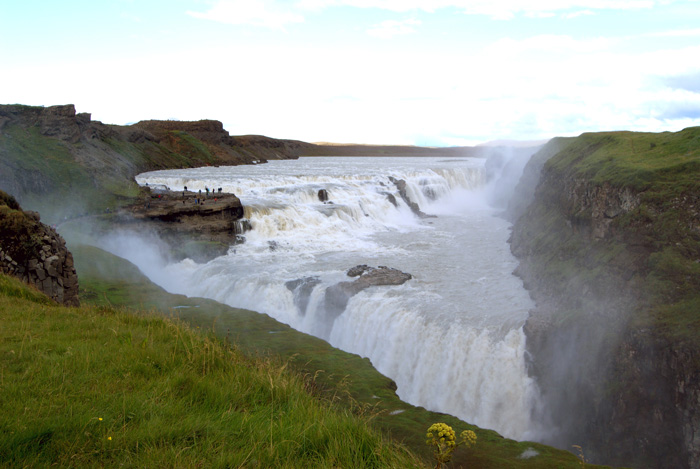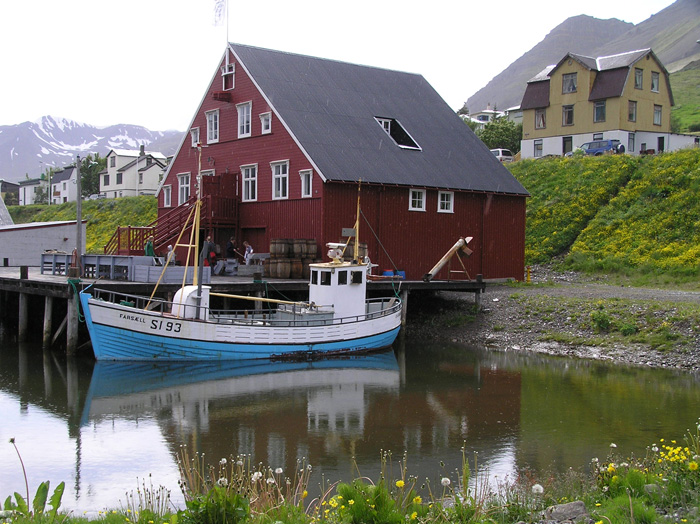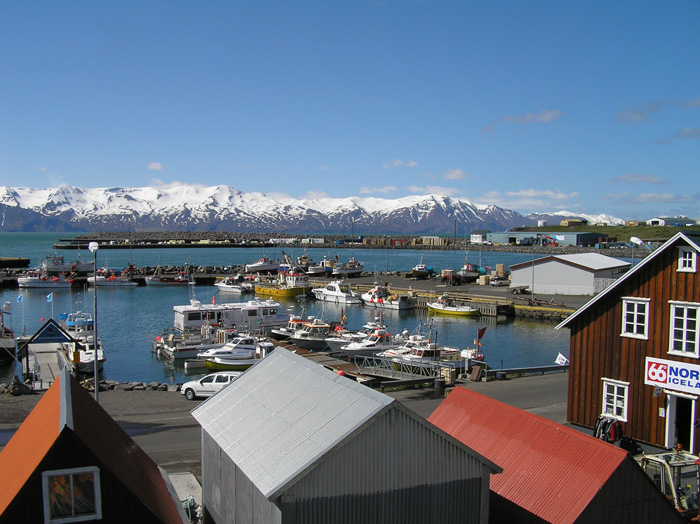Iceland: Landscapes of Fire and Ice
June 17 through July 1, 2017 (15 days)
With Dickinson Professor of Earth Sciences Benjamin Edwards
Read the story: "A 'Jaw-Dropping' Experience"

Sitting astride the mid-Atlantic ridge, Iceland is one of the world’s most geologically active and, therefore, spectacular places. I invite you to explore it with Ben Edwards, professor of earth sciences (formerly geology), on this comprehensive, two-week journey.
Traverse astonishing landscapes of waterfalls, glaciers, geysers, hot springs and volcanoes, plus bird colonies, towns and farms. Professor Edwards, who has taught earth sciences at Dickinson since 2002, will help you understand how these landscapes are formed. Also joining you throughout the trip will be an expert Icelandic guide who will help illuminate your travel experience and emphasize the connections among Icelandic history, Icelandic culture, and the landscape.
The pace of this tour allows you to experience Iceland in-depth. In addition to beginning and ending in the charming capital of Reykjavík, you will stay at two comfortable hotels on the southern and northern coasts for five nights apiece. This exclusive Dickinson alumni adventure is limited to 26 participants, so I encourage you to reserve your space soon!
Sincerely,
Liz Glynn Toth '06
Director of Alumni Relations
Download a PDF of the brochure.

Itinerary
B=Breakfast, L=Lunch, D=Dinner
Saturday, June 17, 2017: Depart Home
Depart the U.S. on flights to Keflavík International Airport (KEF).
Sunday, June 18: Arrive Keflavík, Iceland | Reykjavík
Arrive early in the morning (around 6:30am) at Keflavík and transfer as a group to our hotel in the center of Reykjavík, 40 minutes away. The morning and afternoon are free to explore Reykjavík, Iceland’s charming capital city. We will gather this evening for a welcome dinner. Overnight at Best Western Hotel Reykjavík for two nights. (D)
Monday, June 19: Reykjavík | Reykjanes Peninsula | Reykjavík
Enjoy a short orientation tour this morning of Reykjavík, passing landmarks such as the University of Iceland, City Hall, Icelandic parliament, the Lutheran and Catholic cathedrals, and Höfdi House (best known as the location for the 1986 summit meeting of presidents Reagan and Gorbachev). Depart Reykjavík for the Reykjanes peninsula to see old lava flows, volcanic mountains, hot springs, solfataras, and bird life. Stop at the famous Blue Lagoon, a "natural" geothermal pool in the middle of a lava field, and (if you wish) take a refreshing dip in the warm, mineral-rich water. An indoor pool and geothermal sauna are also on-site. Return to Reykjavík this afternoon to visit the Saga Museum, where we will learn about major events in Icelandic history. (B,L,D)
Tuesday, June 20: Reykjavík | Golden Circle | Hella
This morning we visit Thingvellir, the old parliament site where the national assembly was founded in A.D. 930 (and continued until the late 1800s, when it moved indoors to Reyjkavík). Thingvellir is also a place of geological interest, where the continental plates of North America and Europe come to the surface. Continue on to Skálholt Church, built on the site where southern Iceland’s first bishopric was founded in the 11th century. Visit a greenhouse called Friðheimar, located in Reykholt, where tomatoes are grown year-round despite Iceland’s long, dark winters. After lunch, including a taste of the crop, we continue our drive to the geothermal fields of Geysir for a walk around the hot springs. Nearby is Gullfoss waterfall, which travels 18 miles from the glacier Langjökull in the north to fall more than 100 feet into the canyon of Hvítá. Drive to the town of Hella, where we check-in to our hotel and have dinner. Overnight at Stracta Hotel Hella for five nights. (B,L,D)
Wednesday, June 21: Hella | Westman Islands | Hella
Today we visit Heimaey, one of the Westman Islands (Vestmannaeyjar), where we hope to see the puffins at Stórhöftdi. We will walk up to the crater of nearby Eldfell volcano, which erupted in 1973, nearly filling the harbor (see John McPhee's Control of Nature), and visit the old fort Skansinn. In the afternoon there will be free time to explore Heimaey (perhaps visiting "Pompeii of the North") before returning by ferry to the mainland. (B,L,D)
Thursday, June 22: Hella | Vatnajökull National Park | Hella
Today we drive along the South Coast, passing small villages and crossing the Laki Lava. The 216-square-mile Eldhraun is believed to be the world’s largest flow from a single eruption in historical times. The 1783 eruption that produced the lava affected climate all over the world and devastated the Icelandic population. Drive over huge fields of glacial sands (Sandür) to Vatnajökull, Europe’s biggest glacier, which covers about 8 percent of Iceland. Weather permitting, we will see Iceland’s highest peak, Hvannadalshnjúkur (6,922 ft.). After lunch, stop at the beautiful Svínafellsjökull glacier tongue, one of the many outlet glaciers of the massive Vatnajökull glacier; and continue on to Jökulsárlón, one of Iceland’s deepest lakes, for a boat ride among its icebergs. Return along the coast to our hotel. (B,L,D)
Friday, June 23: Hella | Thjórsárdalur Valley | Hella
In the valley of Thjórsárdalur we follow an easy hiking path upriver to Gjáin, a beautiful, green oasis. Its waterfall is one of several along the river Rauthá, and at the bottom and on its walls are beautiful lava formations. Not far away is Hjálparfoss, a two-stepped waterfall dropping into a round pool near the confluence of the rivers Thjórsá and Fossá. Continue on to the Viking farm Stöng, a reconstructed period homestead roofed with turf. The valley of Thjórsárdalur is dominated by Hekla, Iceland’s second most active volcano, which buried Stöng and other farms in A.D. 1104. (B,L,D)
Saturday, June 24: Hella | South Shore | Hella
Explore Iceland’s south shore today, stopping first at Seljalandsfoss waterfall, a narrow ribbon of water that can be viewed from all sides. Drive through the area most affected by the 2010 eruption of the Eyjafjallajökull volcano and visit the Eyjafjallajökull Visitor Center, which includes a film about the eruption. Afterwards visit Skógafoss, the last in a series of 20 waterfalls on the Skógaá River, and visit Skógasafn folk museum. Drive to Vík í Mýrdal, a pleasant coastal village with a population of 300. Reynisfjara is a beach of black volcanic rock situated between Vík and the rock formations at Dyrhólaey. Just offshore are the sea stacks of Reynisdrangar ("night trolls"), and in the headlands above is a huge, stratified bird colony with kittiwakes on the lower level, puffins nesting in the middle slopes (in summer), and fulmar near the top. Visit the Vík Wool Shop before returning to our hotel in Hella. (B,L,D)
Sunday, June 25: Hella | Kjölur Highland Road | Akureyri
Take a scenic drive this morning through the interior highlands along Kjölur Road, which will give us a taste of Iceland’s desert like center, on our way northward. The “hub” of the Kjölur route is Hveravellir, an enticing geothermal area of fumaroles and multicolored hot pools, where we have the opportunity to take a dip in one of the springs. Continue driving to Akureyri, capital of the north, and check-in to our hotel. Overnight at Hotel Kea for five nights. (B,L,D)
Monday, June 26: Akureyri | Hrisey Island | Akureyri
With about 16,000 inhabitants, Akureyri is Iceland’s largest town after Reykjavík, beautifully located near the head of the fjord. Begin today with a city walk, including the botanical garden, the “old town,” and the Lutheran Church with its panoramic view. In the afternoon, take a short ferry ride to Hrísey, Iceland’s second largest island, which we will tour by tractor. Now with a population of approximately 200, Hrísey has been continuously inhabited since Iceland was first settled. There are no natural predators on the island and bird hunting is forbidden, making it an ideal bird sanctuary. (The birds are very tame and roam the entire island.) After a visit to the 19th-century House of Shark Jörundur, with exhibits related to shark fishing as well as the history of the island, return to Akureyri for the balance of the day at leisure. (B,L)
Tuesday, June 27: Akureyri | Húsavík | Jokulsargljufur National Park | Akureyri
Drive to the small, picturesque fishing town of Húsavík, including a visit to the whale museum, and then along the Tjörnes Peninsula from where (if it is a clear day) the island of Grímsey should be visible. Grímsey is the only place in Iceland that is crossed by the Arctic Circle. Arrive in Ásbyrgi (hoof print of Sleipnir, Odin’s eight-legged horse), part of Jökulsárgljúfur National Park, for a short walk and then visit the Park’s spectacular Dettifoss, Europe’s most powerful waterfall. Return to Akureyri this afternoon. (B,L,D)
Wednesday, June 28: Akureyri | Siglufjörthur | Hofsos | Holar | Akureyri
Today, explore the mountainous Tröllaskagi Peninsula, which has the highest peaks outside the central highlands. Drive along scenic Eyjafjörthur fjord, through the fishing villages of Dalvík and Ólafsfjörthur, with superb views (and perhaps some bird watching) along the way. A new tunnel takes us to Siglufjörthur, an idyllic fishing village barely 24 miles from the Arctic Circle. From 1900 to 1970, Siglufjörthur was the herring capital of the North Atlantic, but today is a quiet home to 1,500 people and we will visit its herring museum. In the afternoon we take in dramatic scenery on a drive to Hofsós, a small village whose natural harbor is one of the oldest trading ports in Iceland, dating back to the 16th century. After a visit to the Iceland emigration museum, our final stop of the day is Hólar, in the Hjaltadalur valley, which was the seat of the bishop and the main regional center from A.D. 1106-1801. Return to Akureyri, over Öxnadalsheithi mountain road, for an evening at leisure. (B,L)
Thursday, June 29: Akureyri | Gothafoss | Lake Mývatn | Akureyri This morning we drive east of Akureyri to Gothafos (“waterfall of the gods”), where statues of pagan gods were thrown into the water in A.D. 1000, and onward to the Lake Mývatn area, featuring abundant bird life, a variety of volcanic and geothermal features, and a wealth of walking trails. At Skútustathir we walk around some of the region’s numerous pseudo-craters. Continue on to Dimmuborgir to see its amazing rock formations, and to the lunar-like crater Hverfjall. It is about 20-30 minutes’ walk up to Hverfjall’s rim, from where you can admire the view around Lake Mývatn. Visit the colorful geothermal fields at Námaskarth, the caldera Krafla, and the Crater Lake Víti (“hell”) before returning to Akureyri. (B,L,D)
Friday, June 30: Akureyri | Skagafjörthur | Borgarfjörthur | Deildartunguhver | Reykjavík
Return to the south today, visiting along the way Skagafjörthur folk museum and the well-preserved historical farm, Glaumbær. Continue on through old lava fields and sculpted valleys and fjords to Borgarfjörthur. Stop at Grábrók volcano, where an easy climb to the top of the crater offers a view over Northurárdalur valley. Marvel at Deildartunguhver, one of the world’s most powerful hot springs, producing 52 gallons of hot water per second; and at Hraunfossar, where crystal clear water seems to appear from nowhere beneath the 1,000-year-old lava field and fall into the muddy glacial river. A ten-minute walk up the river takes us to Barnafoss, where the glacial river has carved strange rock formations. Arriving in Reykjavík, check-in to our hotel and then gather this evening for a farewell dinner. Overnight at Best Western Hotel Reykjavík. (B,L,D)
Saturday, July 1: Reykjavík | Depart Keflavík | U.S.
Departing early this morning as a group from Reykjavík to Keflavík International Airport (KEF). (B)

Tour Prices (Per Person)
- Double Occupancy (20 to 26 participants) $6,745
- Double Occupancy (15 to 19 participants) $7,145
- Single Supplement $1,195
Single room supplement will be charged when requested or required (limited availability).
Your Trip Includes:
- faculty leader Ben Edwards
- 13 nights’ accommodations as per the itinerary
- group arrival and departure transfers at designated times on tour dates
- surface transportation by air conditioned motor coach, with bottled water
- ferry transportation as indicated in the itinerary
- breakfast daily, 12 lunches and 11 dinners (including welcome and farewell dinners with cocktails. Lunches and dinners include coffee/tea)
- all excursions and entrance fees as per the itinerary
- English-speaking local guide/tour manager
- local taxes and service charges
- baggage handling at hotels
- and comprehensive pre-departure information, including a suggested reading guide, travel guide, and packing list.
What to expect
Dickinson travelers will want to be flexible. The itinerary is set well ahead of time and may need to be adapted on the fly for changes in weather, ease of access, transportation, or other factors. For example, mountain roads can sometimes be closed due to snow, even in June, resulting in detours. In late June, we can expect temperatures in the mid-40s and mid-50s F, a monthly rainfall average of about 3” in Reykjavík, and 18-20 hours of daylight (plus an hour or so of “dawn and dusk”). The old traveler’s adage “dress in layers and prepare for anything” is especially appropriate, as rain comes and goes and temperatures vary depending on our destination(s). The bus trips are broken up with short walking stops, and there will be daily walks (approx. 1-3 miles, or 1-2 hours, total per day), as much as one mile at a time. All walks can be done at an easy pace, and aside from walking up (and down) a few small cinder cones there is not much elevation gain/loss.
For More Information:
Contact Dickinson Alumni Global Adventures at 800-856-8951 or Dickinson@studytours.org.
Rates Do Not Include:
Airfare; passport and visa fees; inoculation fees; all airport fees and departure taxes; cost of personal, trip cancellation, and baggage insurance; transportation of excess baggage; items of a personal nature, such as laundry; alcoholic beverages (except as noted above); taxi, telephone, and fax charges; optional excursions or deviations from scheduled tour, airport transfers for those not traveling on the suggested flights. Air Arrangements & Transfers: Round-trip airfare between home and Keflavík (KEF) is not included. Group transfers between the airport and hotel on arrival and departure dates are included based on the designated times. Once you have received your final payment invoice, you should book your flights. If you are considering booking your flights before this time, please contact our office first. We do not accept liability for cancellation penalties related to domestic or international airline tickets.
Passenger Cancellation Penalties:
All requests by passengers for cancellations must be received in writing. Cancellations received at least ninety (90) days prior to departure are fully refunded less an administrative fee of three hundred dollars ($300) per person. Cancellations received between sixty (60) and ninety (90) days prior to departure are fully refunded less an administrative fee of one thousand dollars ($1,000) per person. Cancellations received within sixty (60) days of departure are subject to 100 percent of the tour cost. For this and other reasons, participants are strongly encouraged to purchase trip cancellation insurance. An application will be sent with confirmation of receipt of your deposit. Prices, itinerary and leader are subject to change. Prices quoted are based on group participation and no refunds will be made for any part of the program in which you choose not to participate. It is understood that refunds cannot be made to passengers who do not complete the tour for whatever reason.